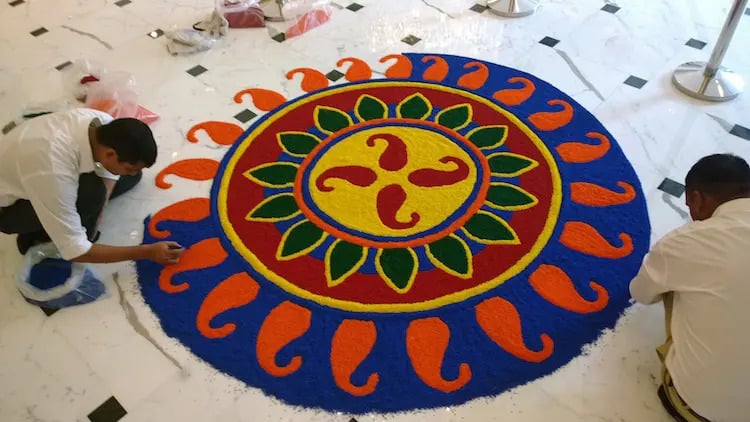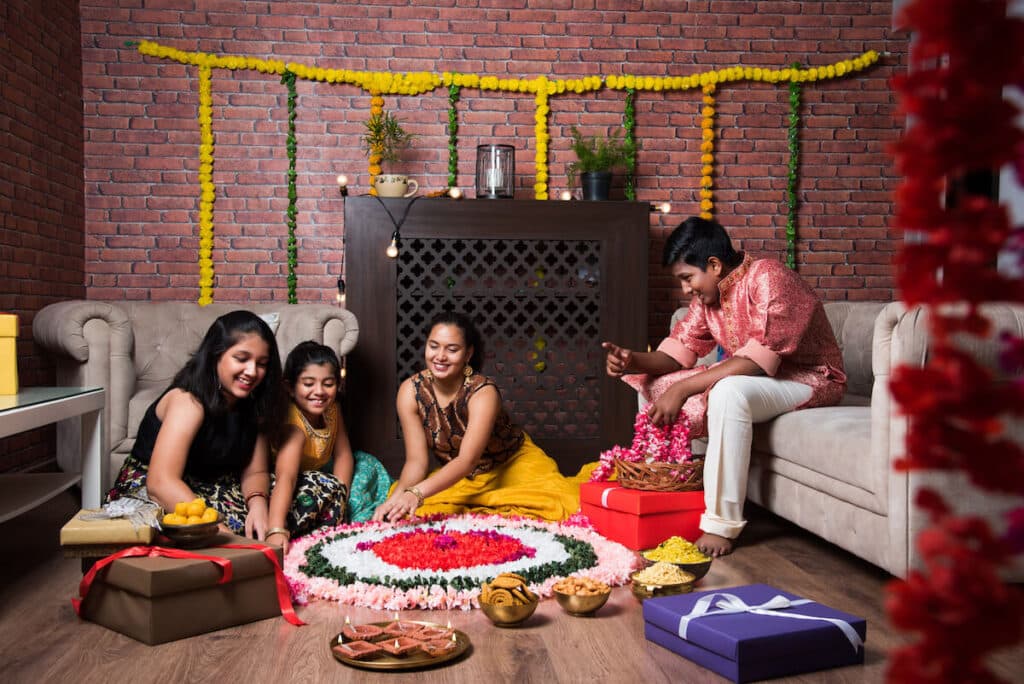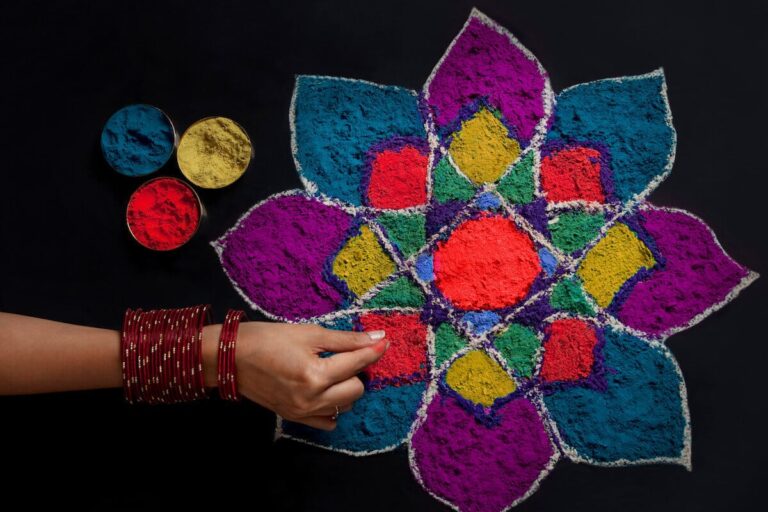Diwali is one of the most popular festivals in South Asia — and around the world, for that matter — with over one billion people celebrating it every year. Also known as Deepavali or Divali, the festival of light is often celebrated with beautiful rangoli designs.
One way to bring the holiday to your home is by making your own traditional Diwali rangoli designs. To help you do so, our team here at Remitly has compiled some tips and tricks to inspire you to get into the Diwali spirit this year with DIY designs made from flowers, rice powder, and more.
What is Diwali?
One of the most important Hindu festivals, the Diwali Indian festival, takes place every year for five days in mid-October or November. Since it’s based on the Hindu lunisolar calendar, the exact dates vary every year. For example, the main festival date for Diwali 2022 was October 24, and in 2023, it takes place on November 12.
Although it’s often associated with India, many countries, including Singapore and Pakistan, treat the Diwali festival as an important public holiday.
The Indian diaspora participates in Diwali celebrations around the world, so there are plenty of ways to make Diwali special, no matter where you are. Since Diwali honors the Goddess Lakshmi, goddess of wealth and fortune, making special rangoli designs celebrating light and happiness is common.
Many participants begin making rangoli months in advance. So, before you wish your friends and family “Happy Diwali” this year, get into the festival spirit by making some Diwali traditional rangoli designs of your own.
What is Rangoli?
Diwali rangoli is a traditional art form that originated in India. The name comes from a Sanskrit word meaning “rows of colors.”
In Tamil Nadu and Kerala, people refer to the rangoli as kolam. The name for rangoli is different in other Indian languages as well, so you may also see it referred to as alpona, ossa, and muggulu in various areas of India.
Patterns can range from a simple basic design to more complex and intricate designs, such as a mandala. You can create unique rangoli designs on the floor using traditional materials, including ground rice powder, flowers, diyas, or special colored powders. Most rangoli consist of either “wet” or “dry” components.
Decorating rangoli is an important part of celebrating Diwali. The design of each piece may have religious or special significance to the artist, and often unique rangoli designs are heirlooms passed down over generations.
Keep in mind that rangoli isn’t just used as a Diwali decoration. Rangoli and kolam designs are also created for other Hindu festivals. Small rangoli designs can last year-round as home decor.
One thing to remember is that even the best rangoli designs aren’t meant to last forever. Rangoli materials like floral designs can easily blow away in the wind or get disturbed by animals. Accepting the impermanence of the finished rangoli is part of the process.
How to Create Your Own Rangoli Designs for Diwali

What better way to celebrate the Indian festival of Diwali than to create your own rangoli designs? Even if you’ve never done it before, it can be easy to do with a plan in hand. Rangoli is truly a DIY art form for people of all experience levels.
To come up with beautiful rangoli designs yourself, all you have to do is choose your materials, select your design, and start creating.
Choose Your Materials
First, decide what materials you will use for your rangoli. One of the great things about rangoli designs is that they are relatively inexpensive to make. Everyone can participate in Diwali regardless of how much money they want to spend.
You’ll find colorful rangoli in homes of all income levels. People improvise and use what they have on hand, making this a festival for people from all walks of life.
Many people use pigment powders especially created and sold for making the bright colors associated with rangoli art. You don’t have to go out of your way to buy them—household spices like turmeric and chili work great for colors like yellow and red.
You can also use flower petals, sand, rice flour, stone or brick powder, or chalk to incorporate different colors and textures into your rangoli patterns.
Grains and beads make a great addition along the borders of rangoli designs to provide a 3-D effect. Diyas or candles are often integrated into some parts of the design. In some places, artists even use sawdust to create floating rangoli patterns on water.
Select Your Rangoli Design and Significance
After you have your materials, decide what the shape of your rangoli will be and its significance to you. If you’re not re-creating a family design, you have a range of options to choose from for your artistic expression. You may want to select a simple rangoli design of a flower or animal or a more detailed representation of a Hindu god or goddess.
For Diwali, images of Lakshmi are common. One idea is to show Lakshmi’s “footsteps” as she enters the home. For other festivals like Holi, Navratri, or Ganesh Chaturthi, you may see rangoli impressions of other deities like Lord Ganesha.
Peacock rangoli designs are also very popular since the peacock is the national bird of India, and its bright features are a natural fit for colorful rangoli designs. And in Kerala, residents celebrate Onam Day with flower rangoli designs made from marigolds and chrysanthemums. This style of rangoli is called “pookalam.”
Once you have an image in mind, decide whether you’ll be able to draw the rangoli freehand or if you need to create a stencil impression to work from. If you choose the latter, draw the rangoli on paper or cardstock. Once you have drawn your rangoli design, you can cut it out to make a pattern to trace.
Many artists share their designs online, so check out some photos for inspiration before you get to work.
Follow Tutorials to Help Make Your Rangoli
Still trying to figure out how to bring your Diwali rangoli designs to life? Fortunately, you can find plenty of tutorials online for easy rangoli designs that require only a few simple household tools and materials. Here are a few of our favorites:
Easy Rangoli Design by Art Easy
If you’re looking for easy rangoli designs, this tutorial from Art Easy is a great pick. It will teach you how to make a basic yet beautiful flower pattern for your DIY rangoli.
Peacock Rangoli by Easy Rangoli
Although the national bird of India may seem like a difficult rangoli design, even a beginner can use the motif. This tutorial from Easy Rangoli will show you how.
12 Flower Rangoli Designs by Sandhya’s Corner
This tutorial from Sandhya’s Corner gives you not one but 12 rangoli design ideas that feature real flowers. Because the guide uses flower petals and whole blossoms, each rangoli has gorgeous textural effects.
How to Make Rangoli Colors at Home with Sand by Rangoli by Maya
If you want to experiment with making your own pigments, this tutorial from Rangoli by Maya will show you a simple technique that uses colored sand.
DIY Glass Color Rangoli Design on OHP Sheet by JK Arts
Want to try making a rangoli out of different materials? This tutorial from JK Arts will show you how to create a glittery rangoli design out of glass.
Beautiful and Very Easy Kolam or Muggu on Coasters by Super Simple Crafts
If you want to create a more permanent rangoli, check out this unique tutorial from Super Simple Crafts that will teach you how to decorate coasters with kolam designs.
Rangoli with Shapes by Vipul Swami Arts
Put a mod spin on your rangoli patterns by incorporating geometric shapes. This tutorial from Vipul Swami Arts will teach you the way to draw geometric shapes and patterns on paper to create a simple rangoli design.
With so many rangoli designs and materials to choose from, your options for creativity are endless. And did we mention that making rangoli is a fun activity for kids, too?
Colored Sand Rangoli by Activityvillage.co.uk
Geared toward kids, this fun tutorial from Activityvillage.co.uk uses colored sand to make simple rangoli patterns. The easy guide makes it easy for kids to complete a fun craft and learn more about how to celebrate Diwali. Best of all, you can customize it and use rice powder, brick powder, rice flour, and other materials you already have at home.
Tulsi Vivah Special Rangoli with 5 to 3 Dots by Malar Home Cooking
With this tutorial from Malar Home Cooking, you can learn how to make a simple rangoli inspired by the tulsi plant, sacred in the Hindu faith.

Where to Display Your DIY Rangoli Art
The most traditional place to display a rangoli is the main entrance of a home. However, you can place yours anywhere that you have suitable flooring.
Depending on your living situation, you may have to get creative with where you display your rangoli. Linoleum tiles and carpeted floors aren’t really suitable for rangoli, so if you need to, you can paint your rangoli design on paper or cardboard instead.
Sending Money Home for Diwali
With Remitly, it’s easy to send money to India, Fiji, Malaysia, and many other countries that celebrate Diwali. We know that even from far away, you want to stay close to family and friends during special occasions like Diwali. We’re here when you need to send money home safely and easily.
Frequently Asked Questions
Rangoli, or festival rangoli (called “aripana” in the state of Bihar), is an ancient Indian art form that comes from the Sanskrit word rangavalli, which means “rows of colors.” Since Diwali honors the Goddess Lakshmi, making rangoli designs celebrating light and happiness is common.
The art of rangoli is an important part of celebrating Diwali. The design of each piece may have religious significance, and often unique rangoli designs are family heirlooms. Creating intricate designs at the entrance of your home is believed to bring good luck and prosperity. During significant occasions such as puja (pooja), rangoli becomes even more meaningful. Families gather to create these beautiful designs as part of their rituals.
Rangoli powder is typically made from a variety of natural and synthetic materials, depending on the desired color and texture. People improvise and use what they have on hand. Many people use pigment powders especially created and sold for making the bright colors associated with rangoli art. You don’t have to go out of your way to buy them—household spices like turmeric and chili work great for colors like yellow and red. You can also use flower petals, sand, rice flour, stone or brick powder, or chalk to incorporate different colors and textures into your rangoli patterns.
The longevity of rangoli can vary based the materials used, the weather, and where it’s placed. Rangoli materials like floral designs can easily blow away in the wind or get disturbed by animals. This makes it perfect for specific celebrations that are temporary, like Pongal (a Hindu harvest festival), Vijayadashami (a festival signifying triumph of good over evil), and the New Year.
Rangoli made from colored powders like rice flour or chalk can last a few days to a week, especially indoors or in sheltered areas. If you use more permanent materials, like colored sand or even paints, these can last for weeks or even months.
First, choose your materials. Some examples are rangoli powder (colored powders, rice flour, or chalk), a chalk or pencil for sketching, a flat surface (like a porch or floor), and flowers, diyas, or decorative items for embellishment. Next, choose your design. Clean the surface where you’ll be making the rangoli. Ensure it’s dry and smooth to help your design look neat. Lightly sketch your chosen design on the ground. This will serve as a guide for filling in colors, especially if you’re considering a border rangoli design.
Carefully fill in your design with rangoli powder. Start from the center and work outward, using a spoon or your fingers to sprinkle the colored powder. Be creative with color combinations; this is key to making your new rangoli stand out. Once the main design is filled in, you can add finer details like borders around the design or small dots or swirls to enhance the look.
Select a simple design to start with, like geometric shapes, floral patterns (like a lotus flower), or basic motifs (like swirls or dots). Peacock rangoli designs are also very popular since the peacock is the national bird of India, and its bright features are a natural fit for colorful rangoli designs. Images of Lakshmi are common – one idea is to show Lakshmi’s “footsteps” as she enters the home.
Other traditional designs not listed above are chakra (wheel) designs, elephants or other animals, dancing figures, symbols like conch (shankha), mango leaves, or kalash (pot), nature-inspired designs, diya (lamp) motifs, mandala designs, and Navaratri patterns. Whether you’re celebrating Diwali, Pongal, or any other occasion, incorporating these motifs can enhance your celebrations and invite good luck into your home.
Yes, you can create beautiful rangoli designs on water surfaces. This unique technique is known as water rangoli or floating rangoli. You need colorful flower petals, colored powders, a water bowl or container, and leaves or small floats.
Fill a shallow bowl or basin with water. Ensure the surface is calm and free from debris. Plan a simple design that can spread out, such as circular patterns, flowers, or geometric shapes. Sprinkle colored powders onto the water surface. The powders will float and spread out, creating vibrant patterns. Use flower petals and leaves to create outlines or fill in sections of your design. You can layer petals for a richer look.
For a festive touch, place small diyas around or on the water surface to illuminate your rangoli. Adjust the placement of petals and powders as needed. The design may shift slightly as petals float.
Yes, rangoli can be made using a variety of materials beyond traditional powders. Fresh petals from flowers like marigolds, roses, and hibiscus can create vibrant and fragrant designs. Colored rice or lentils can also be used to create textured designs. These materials are often used in traditional Indian homes and can be arranged in intricate patterns. Various seeds (like mustard, fenugreek, or pulses) can be used for eco-friendly rangoli. Other options are sand, glitter, paint, fabric, candles, and paper cutouts.
Diwali is not just about rituals; it’s also a time for festivities and fun. Music helps set the celebratory mood. Whether it’s soft instrumental tunes or lively bhajans, the right playlist can evoke feelings of joy, excitement, and togetherness. Many songs associated with Diwali are rooted in tradition and spirituality. They often reflect themes of light overcoming darkness and the victory of good over evil. During puja (pooja) ceremonies, music plays a crucial role because devotional songs and chants can enhance the spiritual experience

